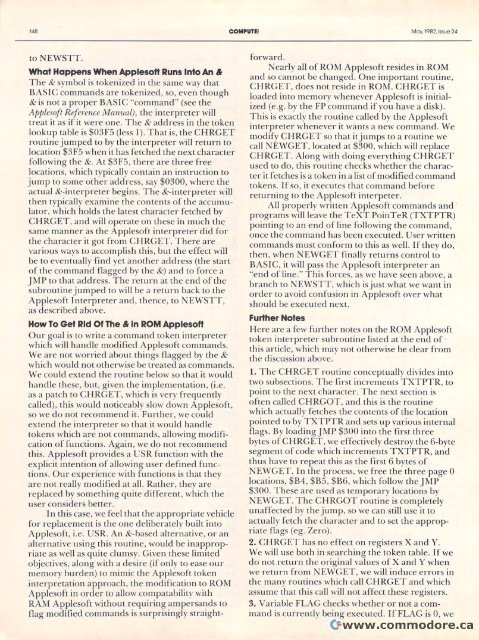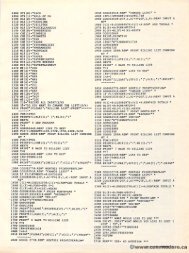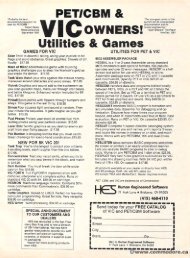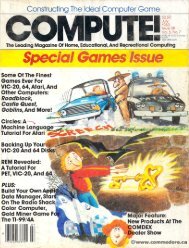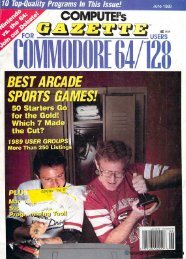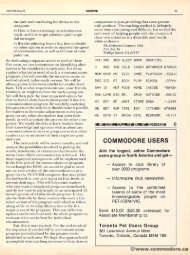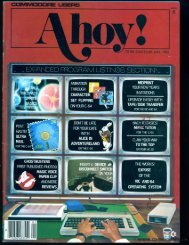You also want an ePaper? Increase the reach of your titles
YUMPU automatically turns print PDFs into web optimized ePapers that Google loves.
"6 1-18 COMPUTEI May. May, 1982. Issue 24<br />
to NEWSTT.<br />
What Happens When Applesoft Applesott Runs Into An &<br />
The & symbol is tokenized in the same way thai that<br />
BASICC commands are tokenized, so, even though<br />
& IS is not a proper BASIC "command" (see the<br />
Applesoft AIJ/Jlesofl ReferenceR Manual), the interpreter will<br />
treat it as if it were one. T he & address in the toke n<br />
treat it as if it were one. The & address in the token<br />
lookup table is $03F5 (less {less I). That is, the CHRGET<br />
routine jumped to by the interpreterr will return to<br />
location $3F5 whenn it has fetched the next characterr<br />
following the 8c. At S3F5, there are three free<br />
followi ng the &. At $3F5 , there a re three free<br />
locations, which typically contain an instruction to<br />
jump to some other address, say $0300, where the<br />
actual &- ^--interpreter begins. The &- it-interpreter interpreter will<br />
then typically examinee the contents of the accumu<br />
lator, which holds the latest character fetched by<br />
C HRGET. and will o pe rate on these in much the<br />
CHRGET, and will operate on these in much the<br />
same mannerr as the Applesoft interpreterr did for<br />
the character it got from CHRGET. H There are<br />
various ways to accomplish this, but the effect will<br />
be to eventually find yet another address (the start<br />
of the command flagged by the &:) &) aand to force a<br />
J M MI* P to that address. The return at the eend off the<br />
subroutine jumped to will be a return back to the<br />
Applesoft IInterpreter and, thence, to NEWSTT,<br />
as described above.<br />
How To Get Rid Of The & in ROM Applesott<br />
How To Get Rid Of The A in ROM Applesoft<br />
QOur UI' goal is to write a command mand token interpreter<br />
which will handle modified Applesoft commands.<br />
We are not worried about things flagged by the 8c<br />
We are not wo rried about things fl agged by the &<br />
which would not otherwise be treated as commands.<br />
We could extend the routine below so that it would<br />
handle these, but, givenn the implementation, (i.e.<br />
as a patch to CHRGET, H which is veryy frequently<br />
called), this would noticeably slow down Applesoft,<br />
called), this would noticeably slow down Applesoft,<br />
so we do not recommend il. it. Further, Funher, we could<br />
extend the interpreter so that it would handle<br />
tokens<br />
which are not commands, allowing modification<br />
of functions.<br />
Again, , we do not recommend<br />
this. Applesoft provides a USR R function with the<br />
explicit intention of allowingg user defined functions.<br />
Our experience ence with functions is that they<br />
are not really y modified at all. Rather, they are<br />
replaced by something quite different, which the<br />
user considers better.<br />
user considers better.<br />
I Inn this case, we feel l thatt the appropriate vehicle<br />
for re place ment is the one d elibe rately built into<br />
for replacement is the one deliberately built into<br />
Applesoft, i.e. USR. An &-based alternative, or an<br />
alternative using this routine, would be inappropriate<br />
as we ll as quite clumsy. Given these limited<br />
riate as well as quite clumsy. Given these limited<br />
objectives, along with a desire (if onlyy to ease our<br />
memory burden) to mimic the Applesoft token<br />
interpretation approach, the modification to ROM<br />
Applesoft in order to allow compatibility witli<br />
flag modified commands is surprisingly straight<br />
memory burden) to mimic the Applesoft token<br />
interpretation approach, the modification to ROM<br />
Applesoft in order to all ow com patability with<br />
RAM Applesoft without requiring ampersands to<br />
flag modified commands is surprisingly straightforward.<br />
Nearl y a ll of ROM Applesoft resides in ROM<br />
Nearly all of ROM Applesoft resides in ROM<br />
and so cannot cannOt be changed. One important rOll routine,<br />
CHRGET, does not reside in ROM. GHRGET is<br />
C H RGET, does not reside in ROM. C HRGET is<br />
loaded into memory whenever A pplesoft is initial<br />
loaded into memory whenever Applesoft is initial<br />
Ized ized (e.g. by the FP command if youu have a disk).<br />
T his is exactl y the routine ca ll ed by the Applesoft<br />
This is exactly the routine called by the Applesoft<br />
interpreter whenever it wants a new command. We<br />
modify CHRGET so that it jumps to a routine we<br />
call NEWGET, located at $300, which will replace<br />
CHRGET. Along with doing everything CHRGET<br />
used to do, , this routine checks whether the characte<br />
r it fetches is a token in a li st of modified command<br />
ter it fetches is a token in a list of modified command<br />
tokens. If so, it executes that command before<br />
returning to the Applesoft interpeter.<br />
All properly wrillen written Applesoft commands and ·<br />
programs will<br />
leave the TeXT PoinTeR (TXTPTR)<br />
pointing to an eend of ol line following ow g the command,<br />
once the command has been executed. User wriuen<br />
written<br />
commands must conform to this as well. If they d o,<br />
commands must conform to this as well. If they do,<br />
then, when NEWGET finally y returns control to<br />
BASIC, it will pass th e Applesoft interpreter an<br />
BASIC, it will pass the Applesoft interpreter an<br />
"end of line." This forces, as we have seen above, a<br />
branch to NEWSTT, which isjust what we want in<br />
order to avoid confusion in Applesoft over what<br />
order to avoid confusion in Applesoft ove r what<br />
should be executed next.<br />
Further Notes<br />
Here are a few further notes on tl,e the ROM Applesoft<br />
LOke tokenn interpreter In subroutine listed at the end off<br />
thiss article, which may not otherwise be clear From from<br />
the discllssion discussion above.<br />
1. I. The CHRGET routine conceptuallyy divides into<br />
two subsections. The first increments TXTPTR, to<br />
point to the next character. r. The next section is<br />
often called CHRGOT, aand this is the routine<br />
which actuallyy fetches the contents off the locationn<br />
pointed to by TXTPTRR ancl and sets up various internal<br />
flags. By 10adingJMP loading $300 into the first three<br />
bytes o f CHRGET, we effectively destroy the 6-byte<br />
bytes of CHRGET, we effectively destroy the 6-byte<br />
segment of codee which increments nts TXTPTR, and<br />
thus have to repeat this as the first 6 bytes of<br />
NEWGET. In the process, we free the three page 0<br />
NEWGET. In the process, we free the three page 0<br />
locations, $ $B4, $B5, $ $B6, which follow the e J JMPM P<br />
$300. These are used as temporary locations by<br />
NEWGET. The CHRGOT C routine e is completelyy<br />
unaffected by the jump, so we can still use it to<br />
unaffected by the j ump, so we can still use it to<br />
actually fetch the characterr and to set the appropriate<br />
flags (eg. Zero).<br />
2. C H RGET has no effect o n registe rs X a nd Y.<br />
2. CHRGET has no effect on registers X and Y.<br />
We will use both in searching the token table. If we<br />
do not return the original values off X and Y when<br />
we return from frotn NEWGET, WGE1 ~ ,<br />
we will induce errors rs in<br />
the many roUlines routines which call CHRGET and which<br />
assume that this call will not affect tl,ese these registers. rs.<br />
3. Variable FLAG checks whetherr or not a command<br />
is currently being executed. If FLAG is 0, we


